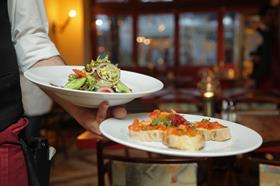
The foodservice and hospitality industry will not recover to pre-coronavirus levels until 2025 at the latest, according to a new report.
The Immediate Future for Hospitality/Foodservice report predicts the industry will shrink by almost half in 2021, with 22 per cent of hospitality outlets closing by the end of this year.
The report states that revenues across the industry will fall by £23bn, achieving only 53 per cent of 2019 levels.
Produced by foodservice analyst and forecaster, Simon Stenning, the good news is that by 2030 he predicts the industry to have grown to a £108bn market.
Stenning said: “The hospitality industry faces enormous challenges and a worrying situation of losing 47 per cent of normal revenues. It is imperative that the government provides significant levels of support given that it is such an important employer and tax generator.
“This is a cautious, not-overly ambitious forecast, but not the worst-case scenario. All sectors of the industry are affected, and it will take time for consumers to revert to their previous behaviours.
“The incredibly hard-working, caring and hospitable nature of the industry will do its utmost to professionally manage the welcoming back of customers and provide safe spaces for us to enjoy our social lives again. However, economic, consumer, profitability, safety and locational factors mean that the industry has to face challenges never encountered before.”
As well as the economic challenges, the sector faces a major task to convince their customers that their venues are safe for guests before they can re-ignite demand for eating and drinking out, according to Stenning.
The report cautions that whilst there is some optimism from various consumer research studies, a recent figure quoted by research firm CGA revealed that 21 per cent of consumers would eat and drink out less frequently than before, and insight from recent research commissioned by Marcus Wareing found that 34 per cent of consumers expected to spend less when they returned to restaurants.
Financial modelling in the report shows that despite decreasing headcount, reducing costs and maintaining margins (which will be harder with potential increases in supply chain costs), a restaurant operating on 50% normal sales plunges to a significant loss, and only a rent reduction, rates holiday and drastic salary cuts will enable many restaurants to break even.
Economic challenges include running sites that are operating at sub-optimal financial levels, and potential stand-offs with property landlords over rent reductions to suit reduced levels of trade.
There will also be the expected increase in unemployment dragging down consumer discretionary spending, whether physically reduced, or through exercising more caution. All together, these economic effects will mean that many sites won’t re-open, or will fail within a few months. The report forecasts that 22 per cent of all hospitality outlets will not be open by the end of 2020.
The report forecasts better outcomes for fast food, which will achieve 77 per cent of normal revenues for the rest of 2020.
Pubs also may also prove hardier due to their local nature and potential benefits from an increase in “staycations”, as Brits stay in the UK for the holiday periods.
Other predictions include a rapid deployment of new technology to help with the challenges, especially with order & pay systems and apps, but also with automation and applied AI. Whereas pre-Covid many operators felt that tech would only play a marginal role in their businesses as the nature of hospitality is all about human interaction, we will see the biggest paradigm shift, as technology solutions that reduce staff contact will now be embraced by both operators and consumers.